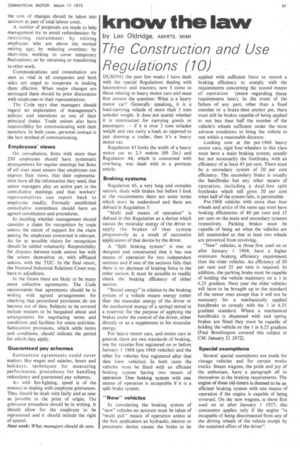know the law
Page 59

If you've noticed an error in this article please click here to report it so we can fix it.
by Les Oldridge AM RTE MIMI
The Construction and Use Regulations (10)
DURING the past few weeks I have dealt with the special Regulations dealing with locomotives and tractors; now I come to those relating to heavy motor cars and must first answer the question: What is a heavy motor car? Generally speaking, it is a load-carrying vehicle of more than 3 tons unladen weight. It does not matter whether it is constructed for parrying goods or
passengers if it is over 3 tons unladen weight and can carry a load, as opposed to just drawing a trailer, then it's a heavy motor car.
Regulation 43 limits the width of a heavy motor car to 2.5 metres (8ft 2in.) and Regulation 44, which is concerned with overhang, was dealt with in a previous article.
Braking systems
Regulation 45, a very long and complex section, deals with brakes but before I took at the requirements there are some terms which must be understood and these are defined in Regulation 3.'
"Multi pull means of operation" is defined in this Regulation as a device which causes the muscular energy of the driver to apply the brakes of that systetp progressively as a result of successive applications of that device by the driver.
A "Split braking system." is one so designed and constructed that it has one means of operation for two independent sections and if one of the sections fails then there is no decrease of braking force in the other section. It must be pos.sible to readily check the braking efficiency of either section.
"Stored energy" in relation to the braking system of a vehicle means energy (other than the muscular energy of the driver or the mechanical energy of a spring) stored in a reservoir for the purpose of applying the brakes under the control of the driver, either directly or as a supplement to his Muscular energy.
For heavy motor cars, and motor cars in general, there are two standard's of braking, one for vehicles first registered on or before January 1 1968 (pre-1968 vehicles) and the other for vehicles first registered after that date (new vehicles). In both cases the vehicles must be fitted with an efficient braking system having two means of operation. One braking system with one means of operation is acceptable if it is a split-brake system.
"New" vehicles
In considering the braking system of "new" vehicles no account must be taken of "multi pull" means of operation unless at the first application an hydraulic, electric or pneumatic device causes the brake to be applied with sufficient force to record a braking efficiency to comply with the requirements concerning the second means of operation (more regarding these requirements later). In the event of the failure of any part, other than a fixed member or a brake-shoe anchor pin, there must still be brakes capable of being applied to not less than half the number of the vehicle's wheels sufficient under the most adverse conditions to bring the vehicle to rest within a reasonable distance.
Looking now at the pre-1968 heavy motor cars, rigid four-wheelers in this class must have a main braking system, usually but not necessarily the footbrake, with an efficiency of at least 45 per cent. There must be a secondary system of 20 per cent efficiency. The secondary brake is usually the handbrake but any other means of operation, including a dual-line split footbrake which still gives 20 per cent when half of the system fails, is permissible.
Pre-1968 vehicles with more than four wheels and artics of the same age must have braking efficiencies of 40 per cent and 15 per cent on the main and secondary systems respectively. Parking brakes must be capable of being set when the vehicles are left unattended so that at least two wheels are prevented from revolving.
"New" vehicles, ie those first used on or after January 1 1968, have a higher minimum braking efficiency requirement than the older vehicles. An efficiency of 50 per cent and 25 per cent is required. In addition, the parking brake must be capable of holding the vehicle stationary on a 1 in 6.25 gradient. Next year the older vehicles will have to be brought up to the standard of the newer ones except that it will not be necessary for a mechanically applied handbrake to comply with the I in 6.25 gradient standard. Where a mechanical handbrake is dispensed with and spring brakes are fitted they must be capable of holding the vehicle on the 1 in 6.25 gradient (Paul Brockington covered this subject in CM, January 211972).
Special exemptions Several special exemptions are made for vintage vehicles and for certain works trucks. Steam wagons, the pride and joy of the enthusiast, have a paragraph all to themselves in the braking requirements. The engine of these old-timers is deemed to be an efficient braking system with one means of operation if the engine is capable of being reversed. On the new wagons, ie those first used on or after January 1 1927, this concession applies only if the engine "is incapable of being disconnected from any of the driving wheels of the vehicle except by the sustained effort of the driver".










































































































